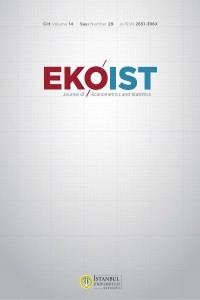Chasing Volatility of USD/TRY Foreign Exchange Rate: The Comparison of CARR, EWMA, and GARCH Models
Chasing Volatility of USD/TRY Foreign Exchange Rate: The Comparison of CARR, EWMA, and GARCH Models
CARR, EWMA, GARCH, volatility USD-TRY,
___
- Andersen, T. G., Bollerslev, T., & Lange, S. (1999). Forecasting financial market volatility: Sample frequency vis-à-vis forecast horizon. Journal of Empirical Finance, 6(5), 457–477. doi:10.1016/ s0927-5398(99)00013-4
- Arı, Y. (2020). From Discrete to Continuous: GARCH Volatility Modelling with R. Retrieved from https://math-stat.net/garch-and-cogarch-modelling.htm
- Arı, Y. (2021a). Volatility spillovers effect analysis during Covid-19 period using EWMA model: The case of health sector stocks in ISE. Ömer Halisdemir Üniversitesi İktisadi ve İdari Bilimler Fakültesi Dergisi , 14 (4) , 1453-1467 . DOI: 10.25287/ohuiibf.917674
- Arı, Y. (2021b). Engle-Granger Cointegration Analysis Between Garch-Type Volatilities of Gold and Silver Returns. Alanya Akademik Bakış, 5 (2), 589-618. Doi: 10.29023/alanyaakademik.838284
- Bayracı, S., & Unal, G. (2014). Stochastic interest rate volatility modeling with a continuous-time GARCH(1, 1) model. Journal of Computational and Applied Mathematics, 259, 464–473. doi:10.1016/j.cam.2013.10.017
- Bollen, B. (2014). What should the value of lambda be in the exponentially weighted moving average volatility model? Applied Economics, 47(8), 853–860. doi:10.1080/00036846.2014.98285
- Bollerslev, T. P. (1986). Generalized autoregressive conditional heteroscedasticity, Journal of Econometrics, 31, pp. 307-327.
- Bollerslev, T. (2010) Glossary to ARCH (GARCH*), in Volatility and Time Series Econometrics: Essays in Honor of Robert Engle, Bollerslev, T., Russell, J. and Watson, M. (Eds). doi:10.1093/ acprof:oso/ 9780199549498.001.0001
- Chiang, M.-H., Chou, R. Y., & Wang, L.-M. (2014). Outlier Detection in the Lognormal Logarithmic Conditional Autoregressive Range Model. Oxford Bulletin of Economics and Statistics, 78(1), 126–144. doi:10.1111/obes.12081
- Chou, R. Y. (2005). Forecasting financial volatilities with extreme values: the conditional autoregressive range (CARR) model. Journal of Money, Credit and Banking, Vol. 37, pp. 561-582.
- Chou, R. (2006). Modeling the asymmetry of stock movements using price ranges. Advances in Econometrics, 20, 231-257.
- Demiralay, S. & Bayraci, S. (2015) Central and Eastern European Stock Exchanges under Stress: A Range-Based Volatility Spillover Framework. Finance a Uver: Czech Journal of Economics & Finance. Vol. 65 Issue 5, p411-430.
- Ding Z., Engle R.F. and Granger C.W.J. (1993). A long memory property of stock market return and a new model, Journal of Empirical Finance 1(1), 83-106.
- Engle, R. F. (1982). Autoregressive conditional heteroscedasticity with estimates of the variance of United Kingdom inflation, Econometrica, 50 (4), pp. 987–1007
- Engle, R. F., & Bollerslev T. (1986). Modelling the persistence of conditional variances. Econometric Reviews 5: 1–50.
- Engle, R. F., & Russell, J. R. (1998). Autoregressive Conditional Duration: A New Model for Irregularly Spaced Transaction Data. Econometrica, 66(5), 1127. doi:10.2307/2999632
- Ghalanos, A. (2020a). rugarch: Univariate GARCH models. R package version 1.4-2. Available at: https://cran.r-project.org/rugarch.pdf
- Ghalanos, A. (2020b). Introduction to the rugarch package. Technical Report Available at: Introduction_to_the_rugarch_package.pdf
- Glosten L.R, Jagannathan R. and Runkle D.E. (1993). Relationship between the expected value and the volatility of the nominal excess return on stocks, The Journal of Finance,48(5), 1779-1801.
- Hentschel, L. (1995). All in the family Nesting symmetric and asymmetric GARCH models. Journal of Financial Economics, 39(1), 71–104. doi:10.1016/0304-405x(94)00821-h
- Higgins, M. L., and Anil. K. B. (1992). A Class of Nonlinear ARCH Models. International Economic Review 33: 137–58.
- Hull, J. C. (2018). Options, Futures, & Other Derivatives, Ninth Edition, Global Edition, Pearson Education Limited.,England
- Markowitz, H. (1952). Portfolio Selection*. The Journal of Finance, 7: 77-91. https://doi. org/10.1111/j.1540-6261.1952.tb01525.x
- Nelson, D. B. (1991). Conditional heteroskedasticity in asset returns: A new approach, Econometrica 59: 347-370.
- Parkinson, M. (1980). The extreme value method for estimating the variance of the rate of return. Journal of Business, 53, 61-65.
- Poon, S.-H., & Granger, C. W. J. (2003). Forecasting Volatility in Financial Markets: A Review.
- Journal of Economic Literature, 41(2), 478–539. doi:10.1257/002205103765762743
- Poon, S.-H., & Granger, C. (2005). Practical Issues in Forecasting Volatility. Financial Analysts Journal, 61(1), 45–56. doi:10.2469/faj.v61.n1.2683
- Ratnayake, M.I.P.R. (2021). Modeling time series with conditional heteroscedastic structure. Unpublished Ph.D. Dissertation. Missouri University, USA.
- Riskmetrics Technical Document (1996) 4th edn, J. P. Morgan. Available at http://yats.free.fr/ papers/td4e.pdf (accessed 12 December 2021).
- Quiros, J.L., & Izquierdo, J.D. (2011). Volatility forecasting with range models: An evaluation of new alternatives to the CARR model. Available at https://repositorio.ipl.pt
- Schwert, G. W. (1990). Stock volatility and the crash of ’87. Review of Financial Studies 3: 103–6. Taylor S. (1986). Modelling Financial Time Series, Wiley, New York.
- Tsay, R.S. (2009). Autoregressive Conditional Duration Models. In: Palgrave Handbook of Econometrics. Springer, pp. 1004–1024.
- Tsay, R. S. (2012). An Introduction to Analysis of Financial Data with R (1st ed.). Wiley.
- Tsay, R. S. (2013). Multivariate Time Series Analysis: With R and Financial Applications (1st ed.). Wiley.
- Unstarched. (2014, July 6). The EWMA model. http://www.unstarched.net/r-examples/rugarch/the- ewma-model/(accessed 12 December 2021).
- Xie H. (2018). Financial volatility modeling: The feedback asymmetric conditional autoregressive range model. Journal of Forcasting. 38:11-28.
- Xie, H., & Wu, X. (2017). A conditional autoregressive range model with gamma distribution for financial volatility modelling. Economic Modelling, 64, 349-356.
- Zakoian, J.-M. (1994). Threshold heteroskedastic models. Journal of Economic Dynamics and Control 18: 931–55
- Yayın Aralığı: Yılda 2 Sayı
- Yayıncı: İstanbul Üniversitesi
Uluslararası Sermaye Akışlarında Ani Duruş: Türkiye Örneği
Emine Ebru ER, Cihan TANRIÖVEN
Türkiye’de Gıda Fiyatları, Döviz Kuru ve Petrol Fiyatları Arasındaki Asimetrik Ilişki
Hüseyin İÇEN, Nimet Melis ESENYEL İÇEN, Buğra POLAT
Association Rules Mining on Retail Data
Hatice DAĞASLANI, Özlem DENİZ BAŞAR
Finansal Zaman Serileri Tahmininde Hibrit Yaklaşımlar: Bir Hisse Senedi Piyasası Uygulaması
Canberk BULUT, Burcu HUDAVERDİ
Global Uncertainty and Exchange Rate Volatility
OECD Ülkelerinde Demokrasinin Çevresel Bozulma Üzerindeki Etkisi
Chasing Volatility of USD/TRY Foreign Exchange Rate: The Comparison of CARR, EWMA, and GARCH Models
